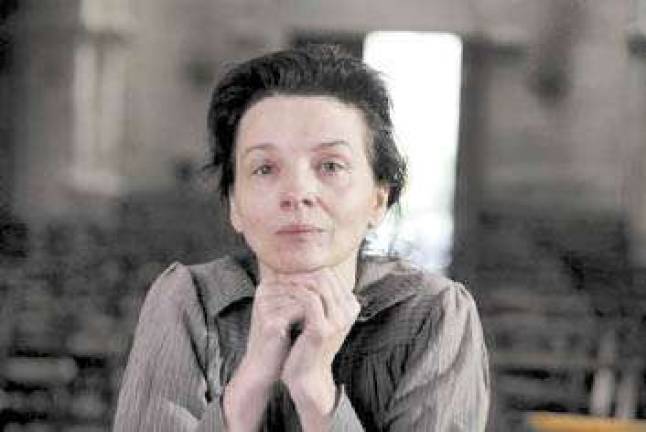Lives of the Saints

Binoche and Bergman make modern
spiritual films
Every Bruno Dumont film resembles an essay. He tells a story as we are accustomed to seeing in mainstream cinema but his focus on plain faces and unprepossessing behavior produces a distinct meditation--this time, in Camille Claudel 1915, on the life of sculptress Camille Claudel, protégé and former lover of Auguste Rodin and sister of the poet Paul Claudel.
Dumont films Camille (played by Juliette Binoche) when she is committed to a remote asylum near Avignon during World War I, as a study that cranks-up our concentration on aspects of normalcy and oddity, sanity and health, difference and individuality, physical captivity and psychological yearning. The story of her legal confinement becomes a deepening presentation of personal travail. Dumont's use of actual mental institution patients is more humane than the bit players in One Flew Over the Cuckoo's Nest and is part of his rigorous observation.
Resisting the blandishments of commercial cinema, Dumont seems to analyze his story while telling it. Camille's hospitalization among inmates in this wooded, medieval environment automatically raises metaphorical facets that save the film from any trite political reading. As Dumont's concentration gets more intense it acquires imaginative richness and a close spiritual reasoning. This is Dumont's speciality, giving him proximity to the masters of metaphysical filmmaking Bresson, Ozu, Bergman and Rossellini but in an original, distinctive style.
In this era of disbelief and skepticism, Dumont's filmmaking is so perfectly, unavoidably tough that its beauty--as when Camille sits in a courtyard and contemplates a bare, gnarled, up-reaching tree as an object in nature, a raw model for sculpture, a veritable cross--is hard won; simultaneously devastating and victorious. As in recent films Hors Satan and Hadewijch, Dumont goes for a clean, unadulterated light, making Camille Claudel 1915 visually brisk, so as not to be obviously sentimental. His meditative sensitivity is striking when Camille physically reacts to a sunny exterior or the chiaroscuro interiors with Paul (Jean-Luc Vincent), brooding and praying in his own, haunting solipsistic torment
Dumont's essayistic style, begun with La Vie de Jesus and Humanite, proposes mankind's fallibility and struggling. "Everything shows the creature's relation to the Creator," the Claudel siblings are told and Dumont shows it without cruel exploitation of the asylum sufferers. He makes Camille and Paul's agon equal to theirs--an "Alleluljah" that looks like mockery but said with sincerity and a therapeutic rehearsal of "Don Juan" by patients who could have posed for the satirist Daumier, provoking Camille's deep anguish. Binoche's most strikingly compassionate moments achieve Lillian Gish expressive immediacy; she and Dumont achieve a superb collaboration.
It's a welcome coincidence that Camille Claudel 1915 opens at Film Forum just as Criterion releases its boxed set "3 Films by Roberto Rossellini starring Ingrid Bergman." This trilogy (Stromboli, Europe '51 and Voyage to Italy) of extraordinary urbane religious movies set the precedent for Dumont's contemporary essays. Rossellini was similarly rigorous but used the melodramatic style of his era to complete the unprecedented transformation of a Hollywood icon into a nearly ascetic pilgrim. No question that Ingrid Bergman's glamour holds these films together; ironically, Rossellini's three studies of sainthood contain the most erotic portraiture of her career.
Binoche's amazing performance is a complete, unglamorous contrast to Bergman (and to Isabelle Adjani's 1990 bio-pic Camille Claudel). She abandons herself to Camille's stress, intelligence, pure joy and sorrow, bursting dramatic convention like Bergman's exhortation at the end of Stromboli--the moment of revelation that Terence Malick attempted to visualize in To the Wonder. Rossellini's saintly dramas are bold and Dumont's are even bolder. Both artists update religious iconography for modern credulity; the result is two kinds of spiritual essays that are cinematic marvels.
Follow Armond White on Twitter at 3xchair